Posted by Vincent Keers on 05-17-2003 10:55 AM:
Luri Bach
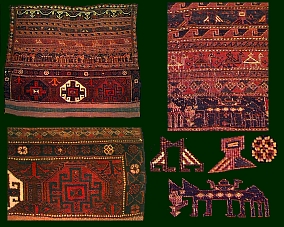
Patrick,
Thought I had some Bachtiar rags.
Now it seems they
are Luri rags.
This is the finest of them.
The chickens are doing the
twist.
Think it shows some woman with Burka too.
The Lion is a bit
strange. Don't know what's hanging at his tail. Don't know what's hanging from
his chin. Don't know what's on his back.
It's all wool. Symmetrical
knots.
Open weft structure.
2 ply twisted.
Do you think it's
Luri?
Best regards,
Vincent
Posted by Patrick Weiler on 05-17-2003 11:52 AM:
Microscope please
Vincent,
It is a bit difficult to tell what you have there because the
photos are smaller than a postage stamp!
The iconography appears to be Luri,
similar to that seen in Opie's book Tribal Rugs, plate 7.23 which shows rows of
animals with "feedbags" below their noses, the guy with his arms spread wide
(but with no legs) riding on top and the very same three-pronged tail he shows
in plate 7.22.
Another similarity is that two Luri bags Opie shows also have
"bow ties" in one row of the field, similar to those on the border of the pile
section of your bag.
Opie says bags of this type have white woolen warps and
red-orange wefts in the pile section.
As for whether your piece was woven in
Varamin or not, the straight line between the sumak and pile section does seem
to be a trait of Varamin Lur weavings, as well as white wool warps.
The
creature with the three-prong tail that Opie shows is from a mid-twentieth
century, 1940's bag. He says:
"Although recent weavings are usually of less
interest from the aesthetic viewpoint, they can be useful in our efforts to
trace the tribal and geographic origins of earlier designs. They also confirm
the opinion of many writers that tribal weaving standards declined irreversibly
when traditional modes of pastoral nomadism were overturned."
As for the
woman with the burka, it does look like the veil with a rectangle of lace where
the eyes are. I believe you have discovered the worlds first Burka
Bag!!!
Patrick Weiler
Posted by John Collins on 05-17-2003 04:28 PM:
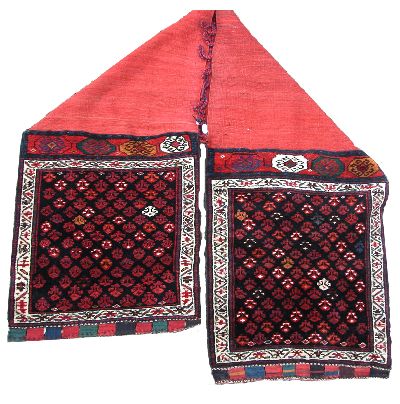
Dear
Vincent,
The piled panel in your bag is reminiscent of the panels in this
pair of Luri Varamin piled bags.
John Collins
Posted by Patrick Weiler on 05-18-2003 02:36 PM:
John,
Not only is the border on your saddlebag set interesting, but
the field design looks a lot like the chanteh field design from a previous
thread:
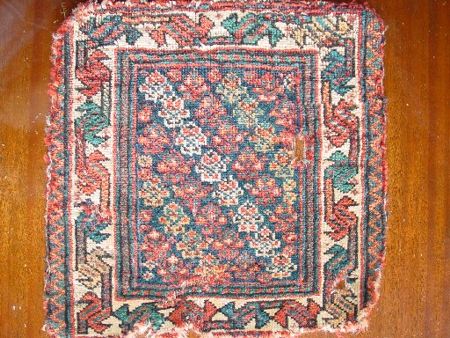
And
it looks even more like the field design from one of the plates in the Tanavoli
book #49, described as a Shahsavan khorjin. It even has the same design of pile
weave panel at the bottom (not shown in this photo).
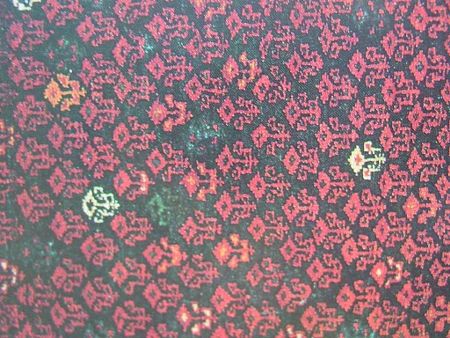
This khorjin also has a
white-ground major border with 8-petalled Varamin flowers. Can this mean that my
small chanteh is a Varamin Shahsavan? Does it mean that your korjin may be
Varamin Shahsavan, too? Yours looks quite a bit more like the plate in
Tanavoli.
The proximity of different weaving groups in the Varamin area has
certainly raised a number of intriguing questions.
Patrick Weiler
Posted by Vincent Keers on 05-18-2003 06:48 PM:
"UUOUOUUUGHHHHH"
Dear Patrick,
Well...it didn't take ages to load.........
I've
a very tiny Apple.
It passed away now. """""""""""""(These are tears)
It
said something like "UUOUOUUUGHHHHH"
From now on, it's going to be much
better.
I've found myself a nice new typewriter.
So next picture will be
like
this:
XXXXXOXXXXXHXXXXXOXXXXXXXXXOXXXXHXX
XXXXOXOXXHXXXHXXOXOXXXXXXXOXOXHXXXX
XXXOXXXHXXXXXXXHXXXOXXXXXOXXXHXXXXX
XXOXXHXXOXXXXXOXXHXXOXXXOXXHXXOXXXX
XXXHXXXOXXXXXXXOXXXHXXXXXOHXXOXXXXX
XXXXOXOXXXXXXXXXOXOXXHXXHXOXOXXXXXX
XXXXXOXXXXXXXXXXXOXXXXXHXXXOXXXXXXX
Hope
this is better.
So maybe it's Luri and maybe it's not.
Think I've seen the
Burka pattern in Bachtiar pieces more often.
Dear John,
But mine
are the Memling kind.
Is this a Luri way of drawing this kind of
pattern?
The size is ±95x80 cm.
And, I do not think these panels are only
in Luri pieces.
So this doesn't help me much.
Thanks
anyway,
Vincent Keers
Posted by Patrick Weiler on 05-20-2003 08:29 PM:
More Details
Here are a couple of images of plate 49 from the Tanavoli book. The full
image shows the panels at the bottom that look very much like those in John
Collin's piece:
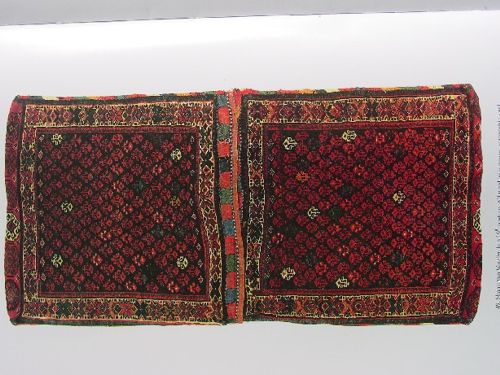
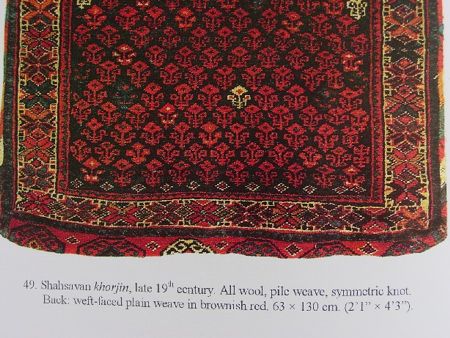
As you can see
from the title, Tanavoli calls it Shahsavan. He says about it:
"Some of the
most exquisite Varamin pile khorjins are Shahsavan work (plate 49)"
But,
other than when describing a Shahsavan gelim as "...unmistakable, as they have
the same bright palette and orderly design conventions as those woven by the
Shahsavan of Hashtrud in Azarbaijan,..." he does not delve into specific
features of the khorjin that would differentiate it from Varamin Arab or Luri
work. So, we are left with issues undecided, making for future findings of
interest yet to be determined.
As Mr. Tanavoli said in his preface, "...the
present book cannot be expected to present a thorough and complete study.
Rather, it marks the beginning of a long and arduous way."
This salon,
then, is a stop along the way to discovering the depth and beauty of the Luri
weaving tradition.
Patrick Weiler





